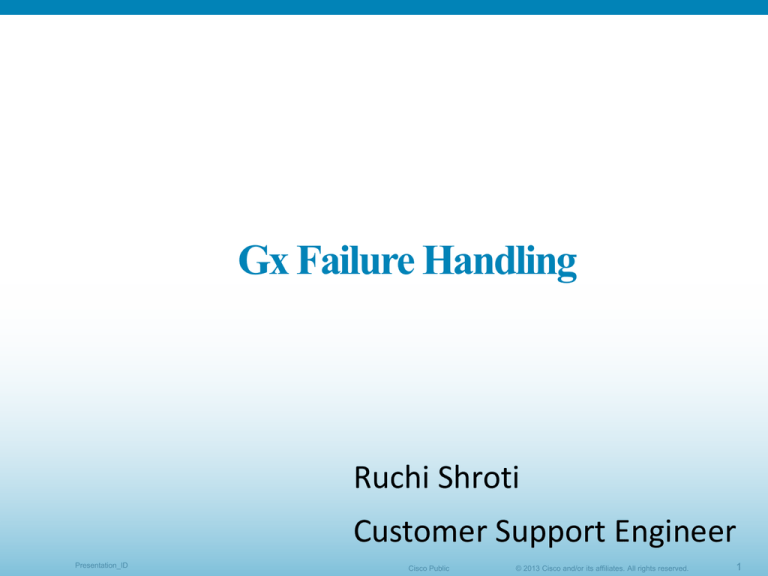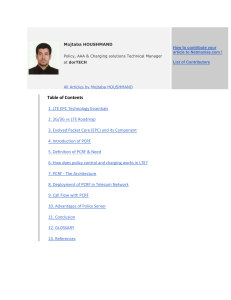
Gx Failure Handling
Ruchi Shroti
Customer Support Engineer
Presentation_ID
Cisco Public
© 2013 Cisco and/or its affiliates. All rights reserved.
1
Table of Contents
Overview
Messages from PCEF to PCRF
Call Flow
Failure Handling/codes
Presentation_ID
Cisco Public
© 2013 Cisco and/or its affiliates. All rights reserved.
2
Overview
This section covers Diameter Policy Control over Gx interface with few scenarios. Policy Control is the
process whereby the PCRF indicates to the PCEF/GGSN/PGW how to control the IP-CAN
(connectivity access network) bearer/session.
Classifications :Policy-Control can be classified and defined as below:
Bearer Binding : Binding is the generation of an association between a Service Data Flow (SDF) and the IP CAN
bearer (for GPRS a PDP context) transporting that SDF. Correlation between definitions in standards and StarOs:
PCC rule = ruledef definition in StarOs
Group of PCC rules = Group of Ruledefs in StarOs
Charging-Action defines charging definition for each Service Data Flow (SDF), such as rating ID etc.
Service Data Flow SDFs represent the IP packets related to a user service (web browsing, email, etc.). SDFs are bound
to specific bearers (PDP context) based on policies defined by the network operator (ruledefs inside rulebase assigned
to session). This binding occurs at the PDN-GW/PCEF and UE using traffic flow templates (TFT). TFT’s contain
packet filtering information to identify and map packets to specific bearers (PDP Context). The filters are configurable
by the network operator, but at a minimum will contain five parameters, commonly referred to as a 5-tuple (known as
shallow packet inspection ECS).
The parameters include:
• The source IP address
• The destination IP address
• The source port number
• The destination port number
• The protocol identification (i.e., TCP or UDP).
Presentation_ID
Cisco Public
© 2013 Cisco and/or its affiliates. All rights reserved.
3
Gating Control: Gating control is the blocking or allowing of packets, belonging to an SDF, to pass
through to the desired endpoint. A gate is described within a PCC rule (ruledef) and gating control is
applied on a per SDF basis (inside charging action shape/drop/charge). The commands to open or
close the gate leads to the enabling or disabling of the passage for corresponding IP packets (inside
charging action we have option to drop traffic when ruledef is matched, ex drop Facebook traffic for
session). If the gate is closed, all packets of the related IP flows are dropped. If the gate is opened,
the packets of the related IP flows are allowed to be forwarded.
Event Reporting: Event reporting is the notification of and reaction to application events to trigger
new behavior in the user plane as well as the reporting of events related to the resources in the
Gateway (PCEF). Event triggers may be used to determine which IP-CAN session modification or
specific event causes the PCEF to re-request PCC rules (like QoS change). Although event trigger
reporting from PCEF to PCRF can apply for an IP CAN session or bearer depending on the
particular event, provisioning of event triggers will be done at session level. The Event Reporting
Function (ERF - located on PCEF/PGW) receives event triggers from PCRF during the Provision of
PCC Rules procedure and performs event trigger detection (PCRF notifies PCEF on which changes
for this session PCRF wants to be updated from PCEF). When an event matching the received event
trigger occurs, the ERF (PCEF/PGW) reports the occurred event to the PCRF. If the provided event
triggers are associated with certain parameter values then the ERF includes those values in the
response back to the PCRF. The Event Reporting Function is located in the PCEF for ASR5x00 - the
standards allow for this to be in the Access Network gateway (e.g. SGW) when PMIP is used for
S5/S8 but this is not a common deployment model.
Presentation_ID
Cisco Public
© 2013 Cisco and/or its affiliates. All rights reserved.
4
QoS Control: QoS control is the authorization and enforcement of the maximum QoS that
is authorized for an SDF or an IP-CAN bearer. In case of an aggregation of multiple SDFs
(for GPRS a PDP context), the combination of the authorized QoS information of the
individual SDFs is provided as the authorized QoS for this aggregate. This is another
difference between R7 where QoS authorised per bearer and R8 onwards where QoS is
authorised per SDF.
QoS control per SDF allows the PCC architecture to provide the PCEF with the
authorized QoS to be enforced for each specific SDF.
The enforcement of the authorized QoS of the IP-CAN bearer may lead to a
downgrading or upgrading of the requested bearer QoS by the Gateway (PCEF) as part
of a UE-initiated IP-CAN bearer establishment or modification. Alternatively, the
enforcement of the authorized QoS may, depending on operator policy and network
capabilities, lead to network-initiated IP-CAN bearer establishment or modification. If
the PCRF provides authorized QoS for both, the IP-CAN bearer and PCC rule(s), the
enforcement of authorized QoS of the individual PCC rules takes place first.
Presentation_ID
Cisco Public
© 2013 Cisco and/or its affiliates. All rights reserved.
5
For session establishment and policy control over Gx, the
following messages are used:
1. Initiated from PCEF to PCRF (PULL):
• CCR-I : Initialization of session from PCEF to PCRF, exchange of session information
from subscriber, and all relevant information that PCRF might use to determine logic
and policies that will apply. There is one Gx CCR-I per IP-CAN session (example for
primary and all secondary PDP context or Default bearers plus all Dedicated bearers).
• CCA-I : PCRF’s answer to CCR-I request. In this message PCRF includes result-code
that defines if authorization is successful, or not. Also with authorization for session,
PCRF provides a set of attributes that PCEF should enforce to subscriber’s session.
Result code: defining if PCRF accepts session or terminates it. Valid codes and
expected causes are reused from 3GPP 29.212, RFC 4006 and RFC 3588.
QoS change: and THP/ARP setting change for session
Presentation_ID
Cisco Public
© 2013 Cisco and/or its affiliates. All rights reserved.
6
Event trigger provisioning : setting monitoring points triggers for which PCRF wants to
be notified from PCEF PCC rule and/or group of PPC rules install/remove
commands:activating/deactivating pre-defined dynamic rules on PCEF, with option to
set predefined future time of automatic activation and deactivation.
Volume monitoring and reporting: Setting up thresholds for monitoring keys, which
enables PCEF to count and report counted volume per Service Data Flow (or set of
SDFs) or for entire session
• CCR-U : PCEF sends update for session, based on one of the triggers that
PCRF set during session initialization. Update message is sent together with
trigger that caused this update message, and with attributes that are related
to the change, for example new RAT TYPE, new QOS, Usage-Report due to
Volume monitoring threshold exceeded, access network gateway (e.g.
SGW/SGSN) change or Revalidation timer
• CCA-U : PCRF answer to CCR-U request. In this message PCRF has full
control to deny/modify policies on PCEF for subscriber session, by setting
up result-code and provisioning any of the rules and applicable
modifications with same procedure as in INIT message (Changing QoS,
Setting new event-triggers, installing new rules, setting up or discarding
volume monitoring).
Presentation_ID
Cisco Public
© 2013 Cisco and/or its affiliates. All rights reserved.
7
• CCR-T : PCEF sends TERMINATE request when subscriber session is closed,
due to any reason (UE PDP disconnection, or administrative disconnect by other
entity). In termination request message, PCEF reports termination-reason, and
also any outstanding information that was valid at session termination stage
(Like reporting used volume or active volume-monitoring threshold).
2. Initiated from PCRF to PCEF (PUSH):
RAR : PCRF can initiate change by itself using Re-Authorization-Request. Unlike
Gy and Diameter Credit Control, this message does not trigger a CCR-U, but
instead this is used when PCRF needs to modify session policy control during
active session. With RAR, PCRF can push new policy attributes like an INIT
response and UPDATE response messages, and also PCRF can request explicit
volume usage-report.
RAA : PCEF answer to RAR. Used to respond if PCEF accepted changes in RAR,
and to provide current volume usage-report if PCRF requested it.
Presentation_ID
Cisco Public
© 2013 Cisco and/or its affiliates. All rights reserved.
8
Session Establishment & Disconnection call-flow
Presentation_ID
Cisco Public
© 2013 Cisco and/or its affiliates. All rights reserved.
9
Gx session failure-handling
Failure Handling Procedure for Gx can be invoked under the following
scenarios:
1 DIABASE ERROR:
This happens in the path of the request, mainly due to socket-based errors like
link failure which happens when the server goes down.
2 APPLICATION BASED TIMER:
Default value "diameter request-timeout 10" inside ims-auth-service / policycontrol
3 RESPONSE TIMEOUT:
Default value "response-timeout 60" inside diameter endpoint configuration.
The following table(in attached sheet) explains the failure-handling logic for Gx:
Presentation_ID
Cisco Public
© 2013 Cisco and/or its affiliates. All rights reserved.
10
Thanks !!
Presentation_ID
Cisco Public
© 2013 Cisco and/or its affiliates. All rights reserved.
11










